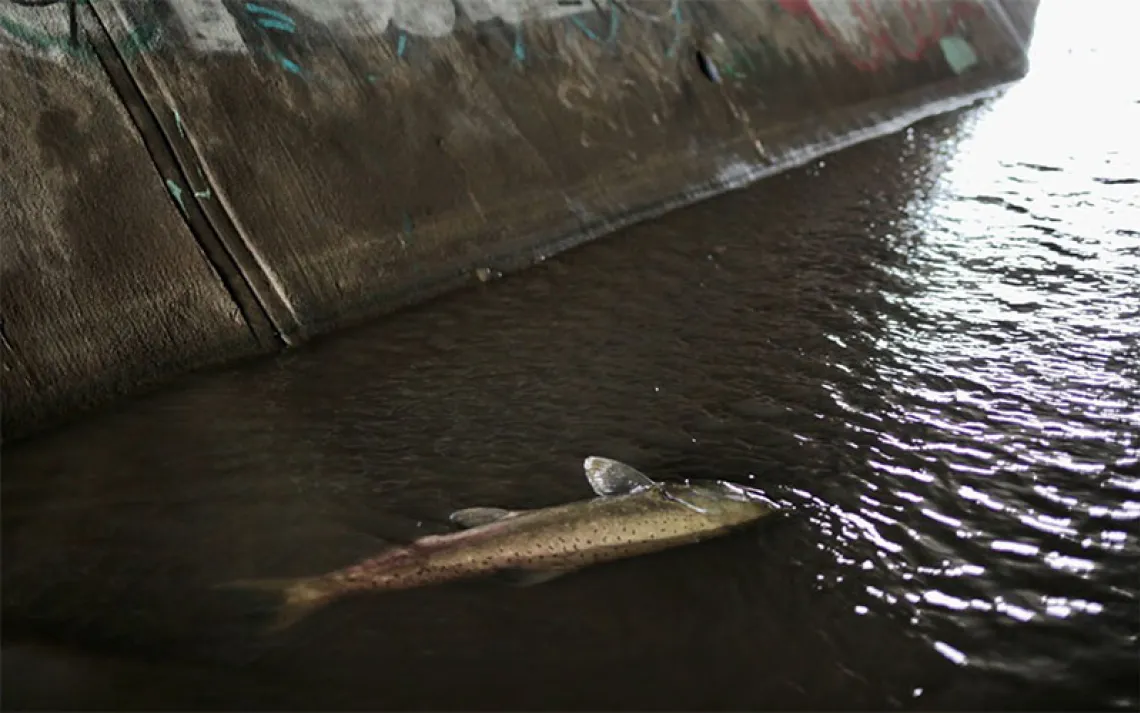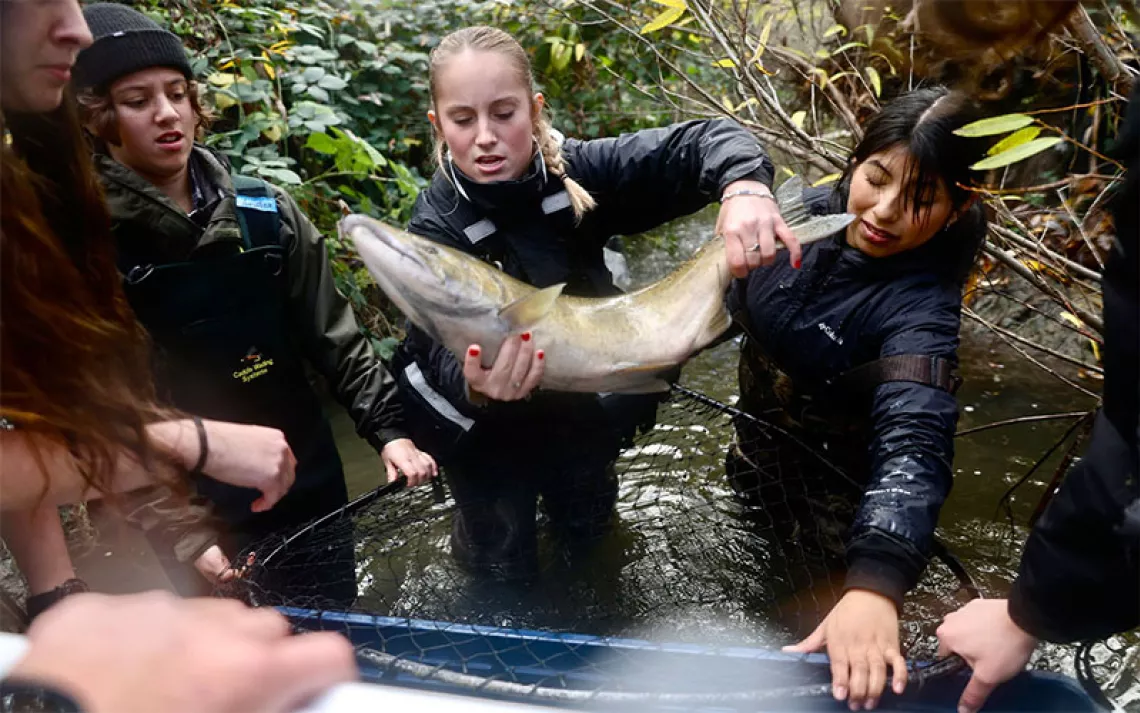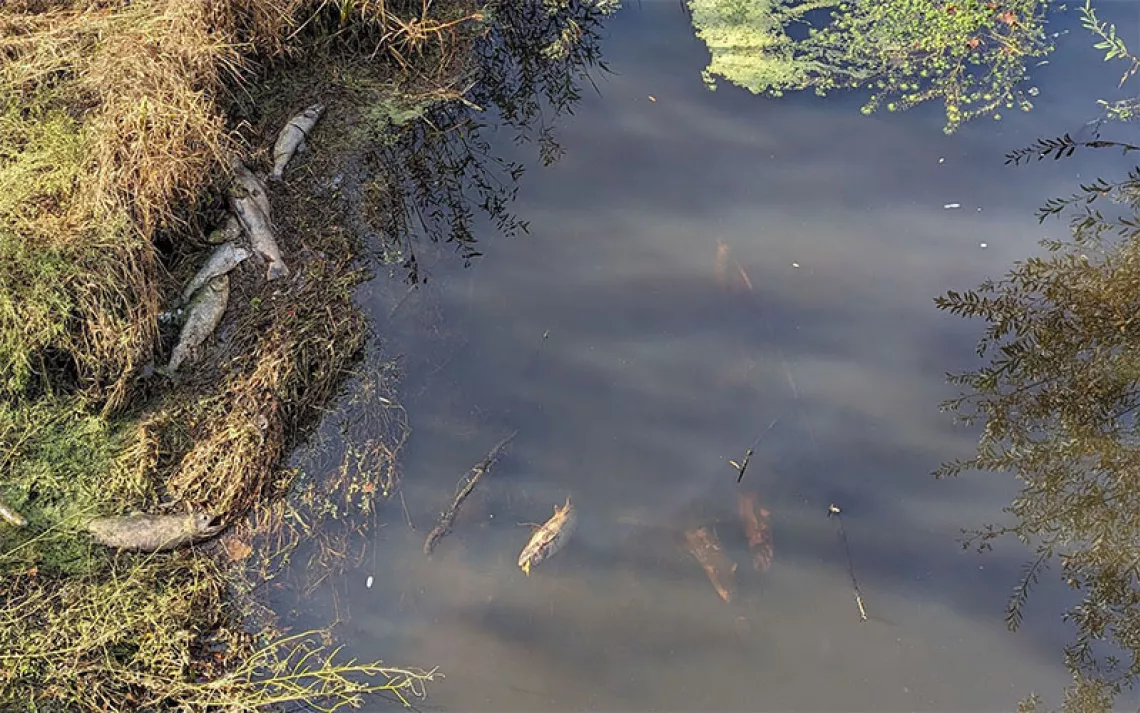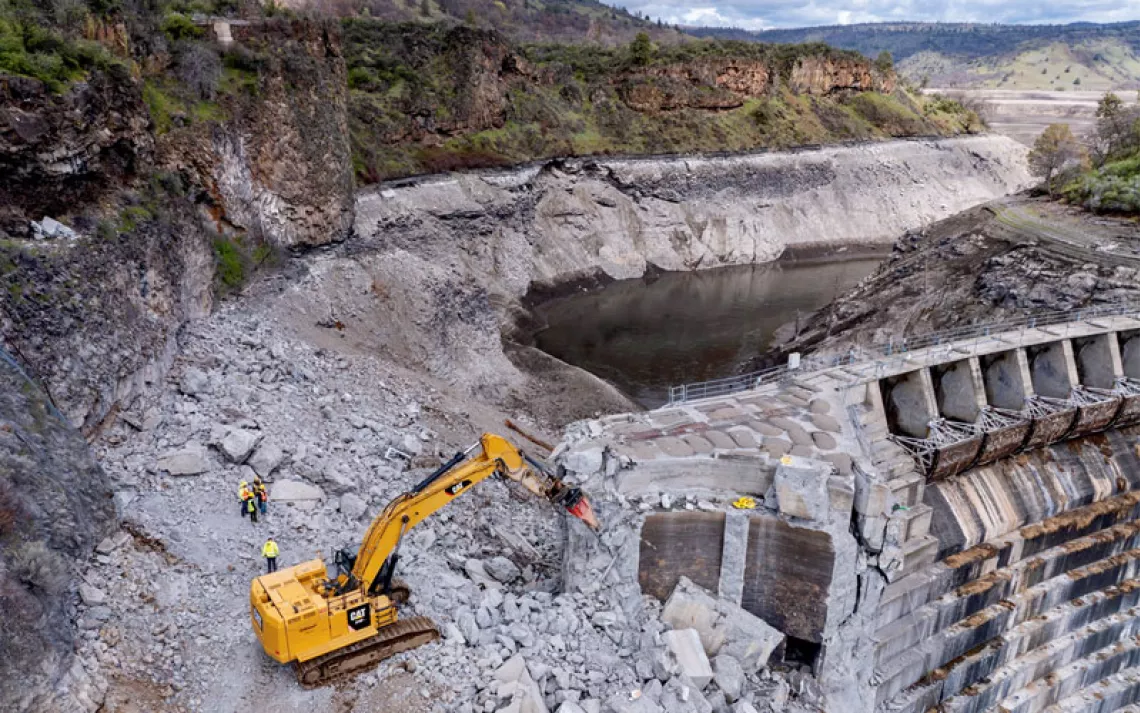Native Welder Crafts Artwork to Help Free the Snake River Salmon
A steel sculpture will be the centerpiece of a Pacific Northwest tour calling on the US government to honor its treaties with Indigenous nations
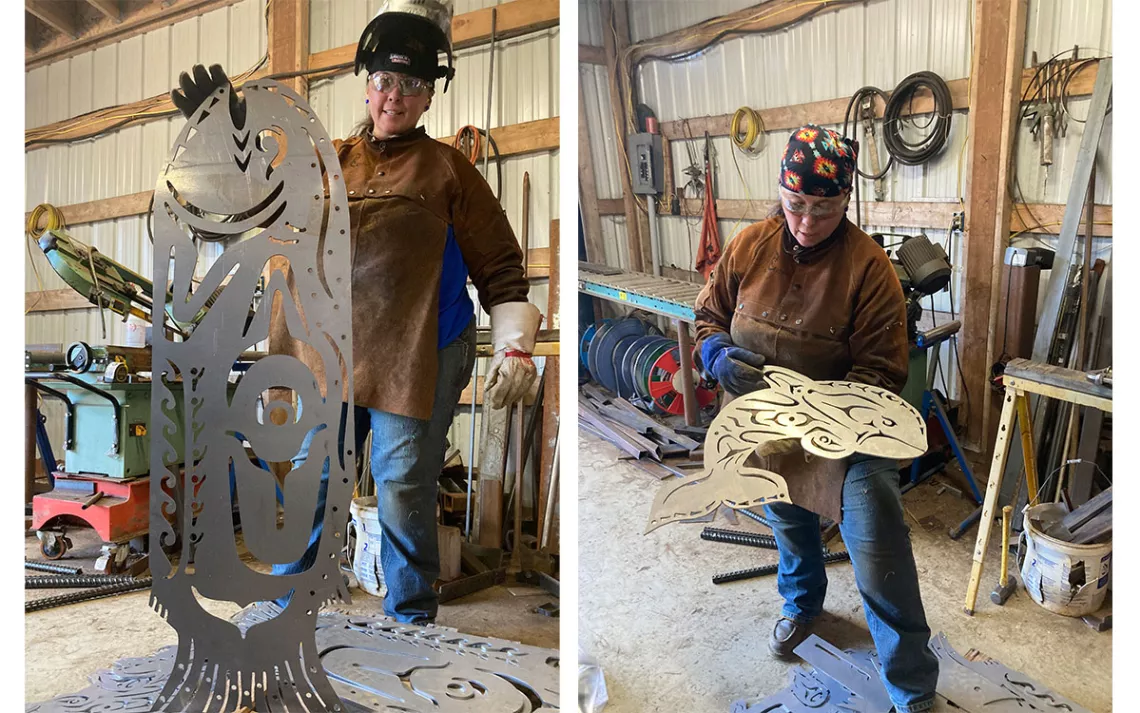
Lummi welder Cyaltsa with her work-in-progress. | Photos by Jason Mark
Cyaltsa Finkbonner got introduced to the distinctly modern skill of welding through the traditional craft of fishing. When she was growing up, her father, Larry Kinley, was among the most accomplished fishermen of the Lummi Nation, a Pacific Northwest tribe that boasts the largest Native fishing fleet outside Alaska. She often worked with her dad and sister on the family’s salmon-fishing boat, and one day, when she was 19, she expressed curiosity as her dad started work on a welding project.
“He said, ‘Grab that hood and come watch me,’ and I was like, ‘Wow, that’s cool,” Cyaltsa, now 52, remembers. (She is in the process of changing her English surname and prefers to use her Lummi traditional name, pronounced sigh-alt-suh.) Her father suggested that she should look into welding as a career because, as he put it, “they say women make good welders, with their steady hands.” Someday, he said, maybe she could make them an aluminum boat for their fishing operation.
Cyaltsa never did get the chance to build that boat, but she did make a career out of welding. As a union ironworker, she has helped build skyscrapers throughout downtown Seattle, spent several years on a massive government project in Hawai’i, and served as an instructor to apprentice welders. During her time in Hawai’i, she began to do artwork featuring Native motifs and inspirational messages. They are mostly acrylic paintings and pen and ink drawings printed on T-shirts and stickers that she sells through her website.
This summer, Cyaltsa had the opportunity to combine her welding trade, her passion for art, and her commitment to Indigenous sovereignty and salmon recovery. She spent six weeks conceiving and then fabricating an intricate, eight-feet-in-diameter steel sculpture that will be the centerpiece of a Native-led campaign calling for breaching four dams on the Lower Snake River.
“I’m totally blessed to be able to do this,” Cyaltsa said recently as she worked on some of the last-to-final stages of the sculpture at a welding shop not far from Tacoma, Washington. “I’m honored to be a part of it. With any of my artwork, there’s typically a message. This is not just something pretty to look at—I want to reach people and educate them.”
The message of her new steel sculpture is as sharp and precise as the laser cutting on the artwork: It’s long past time for the United States to honor its treaties with Pacific Northwest Indigenous nations and do everything possible to revive endangered salmon populations. Starting September 23 in Olympia, Cyaltsa sculpture will travel to seven cities throughout Idaho, Oregon, and Washington to help generate increased public support for dam decommissioning. The tour—which will involve rallies at each stop and conclude with an October 1 event at Seattle Town Hall—is being organized by Se’Si’Le, a Native group that promotes Indigenous sovereignty and which has put on similar art-focused, grassroots campaigns in the past.
For millennia, salmon have been the cultural and economic foundations of Indigenous cultures throughout the Pacific Northwest. In recent decades, however, salmon runs have collapsed. Fourteen separate populations of Chinook, chum, coho, sockeye, and steelhead are listed as threatened or endangered under the Endangered Species Act. In response, Native American nations in the region have lobbied state and federal authorities to take aggressive action to restore salmon numbers—arguing that governments’ role in contributing to the salmon collapse represents a violation of the tribes’ treaties, which guarantee their right to hunt, gather, and fish in their “accustomed places.”
A central target of the tribal advocacy has been the choke-chain of dams that impede salmon from returning to their spawning areas. Indigenous groups and environmental organizations have focused much of their advocacy on four dams on the Lower Snake River that, they argue, are of limited economic value, produce relatively little electricity, and yet still do vast damage to salmon and other aquatic species.
In the fall of 2020, the US Fish and Wildlife Service released an updated salmon-recovery plan for Snake River salmon. But it was, in the words of Sierra Club volunteer leader Bill Arthur, “an iteration of the same old stuff that hasn’t worked before.” A group of 10 environmental groups, including Sierra Club, the National Wildlife Federation, and Earthjustice, then sued the Army Corps of Engineers, the Bonneville Power Administration, and the Bureau of Reclamation, arguing that the plan was insufficient. The Nez Perce Tribe—the Native nation whose treaty-guaranteed fishing rights are most directly impacted by the Snake River dams—has filed its own lawsuits against the federal agencies and the State of Oregon.
“We are basically suing because the environmental impact statement … doesn’t include breaching the four dams,” Shannon Wheeler, chair of the Nez Perce Tribe, told Sierra. “The general public has to understand that the threatened salmon species are facing extinction, and it’s the four Lower Snake dams that are putting them on the trajectory of extinction.” He continued, “We are really looking for our federal partners and our partners in treaty, the US government, to come to the table with us and find these solutions and take actions that will respect and honor the treaties.”
The seven-city road show featuring Cyaltsa’s steel sculpture comes in the midst of a pause in the litigation, and it’s meant to demonstrate to state and federal officials that there is strong support for breaching the four dams.
“You’ve got rivers that have been turned into lakes, and the natural world is at a tipping point, and you’ve got the salmon going extinct,” Jay Julius (or W’tot Lhem), a former chair of the Lummi Nation and now president of Se’Si’Le, told Sierra in between fishing for pink salmon and going out crabbing. He said this week’s tour is meant to "tell the story that the natural garden is all but destroyed right now” and to encourage non-Natives “to open up their imagination to what once was.”
Above all, the campaign is intended to direct public attention to the ongoing violation of US-Indigenous treaties. “You have a treaty with the Nez Perce, and it’s been completely dishonored. Keeping these dams up is a dishonor and a disgrace to the agreement your forefathers entered into with the sovereigns of this land.”
Se’Si’Le has a long history of using art as a vehicle to promote Indigenous sovereignty. In recent years, the organization and its partners have put together road shows featuring traditionally carved totem poles to call for the liberation of the captive orca Tokitae (who recently passed away) and to highlight Native-led campaigns against extractive industries, among other causes. The gatherings are often spiritually intense—including prayers and the laying of hands upon the carved totem poles—and they have proved to be a potent way to alchemize art into civic action.
“Art brings people together—it’s like fish, like a meal,” Julius said “We come together through meals, and art brings people together. We’ve seen that art creates connections and tells a story. So there’s a story within all of the art, and there’s a spirit within that art.”
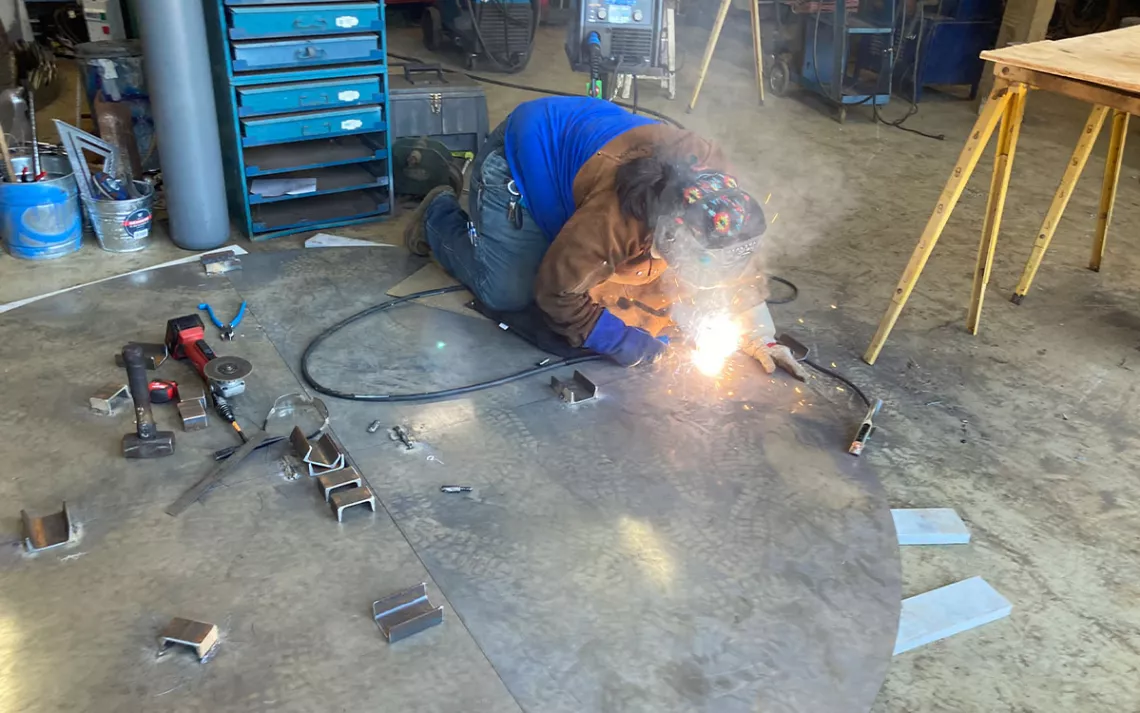
Lummi artist Cyaltsa does some welding touch-ups on her piece. | Photo by Jason Mark
In the past, Lummi artist Jewell James of the House of Tears Carvers has usually created the totem poles, which have been carved out of centuries-old red cedar trees. This time, the members of Se’Si’Le wanted to do something different. James came up with the overarching vision for the artwork. Next, Cyaltsa turned James’s concepts into hand-drawn sketches, which she then converted into a digital rendering. Once the design was finished, Cyaltsa sourced 3/16-inch steel plates that were sent to a laser-cutting company called Metal Creatures that did the cutouts. Then she got to welding.
“I’ve never done anything on this scale before, so it’s really cool,” Cyaltsa said. “I’ve done little tiny pieces of artwork just from scrap metal or something. But intricate stuff like this—you know, you really have to take your time with it. When it’s someone else’s vision, you have to really take care.”
The completed sculpture is an eight-feet-in-diameter metal circle, split into four quadrants like a Native American medicine wheel. The base will be encircled by four upright salmon and four upright feathers with the words Prayer Warrior peaking out amid the metal quills. Laying flat on the surface are four totems: a bison, an eagle, a grizzly bear paw, and an orca, or Qwe’lhol mechen in the Lummi language, which means “our relative that lives under the sea.” In the center of the circle sits a metal bowl for the burning of ceremonial sage and sweetgrass.
One of the most challenging things about the fabrication was making something that could be easily assembled and disassembled during the seven-city tour. Each of the upright feathers and salmon weighs more than 60 pounds, and the entire sculpture weighs hundreds of pounds, so the organizers needed something that could be transferred from location to location without the need for heavy machinery. After the road show wraps up, the piece will be permanently installed in the Nez Perce nation.
The metal sculpture is titled “All Our Relations,” which is meant to convey the Lummi worldview of interdependence between human communities and wild nature. “When I was a child, the elders would always say that—‘all our relations,’ hy'shqe siem,” Julius said. “All of our relations is water, it’s the land, it’s air—everything. That is the important message that we’re trying to get across: that unsevered relationship with waters, and the simple commonplace understanding that we can’t live without it. … I’m not saying that everyone needs to develop a relatedness, but if we did find that reconnection, it would solve a lot of problems.”
For Cyaltsa, the idea of “All Our Relations” reveals humans’ responsibilities toward other species. “‘All Our Relations’ means we want to save, and help thrive, the river and the sea and bring it back to how it was before we started all the digging and the extraction,” she said. “We have to take care of them—you know, the salmon, the eagles, the orcas, the grizzly—and keep them thriving.”
She hopes that her sculpture will spark some people to consider what extra actions they can take to help protect wildlife and the ecosystems they rely on.
“I want them to ask their own question: 'What can I do to help?'” she said. “The little things add up. If everybody did at least one good thing to help the environment and help clean the rivers and clean the oceans, together we can thrive. That’s what I want: to inspire people. Period.”
 The Magazine of The Sierra Club
The Magazine of The Sierra Club
